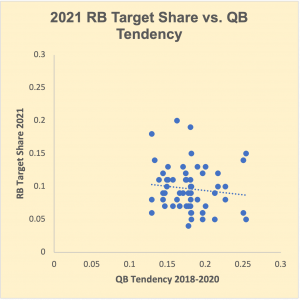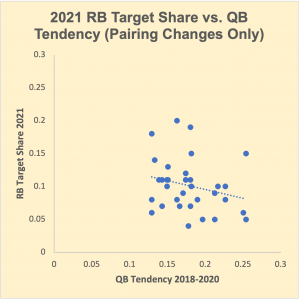Targets are perhaps the most important tool for a running back to score fantasy points. They are worth 2.37 times more fantasy points than carries and do not disappear when the player’s team is down multiple scores. Last year, I found that league-winning running backs overwhelmingly have high target shares. It seems important to understand how a running back’s targets come to be.
There are two schools of thought about what causes some running backs to have high target shares and others to have low target shares. Some would say running back targets are “earned.” In other words, some running backs are simply better at commanding targets than others, whether due to better route running, hands, or ability after the catch. Quarterbacks throw to the running back if they are open and will help the offense advance down the field.
The other school of thought might counter that running back targets are “inherited.” The argument goes that some quarterbacks and offenses tend to check down to the running back more than others. These targets will occur regardless of how talented the running back is; they are “inherited” because the player is simply on the right offense at the right time.
The answer to this question matters more in fantasy football than one might think. If Nick Chubb were traded to the Raiders, where Derek Carr has for years been among the league leaders in throwing to running backs, would you expect Chubb’s target share to increase?
As it turns out, a majority of Twitter believes it would:
Trying this again for a bigger sample. Do you think running backs earn targets, or inherit them based on their QB's tendency to check down? @MyFantasyLeague
— Ryan Heath (@RyanJ_Heath) May 12, 2022
Aside from the low engagement on this poll (follow me @QBLRyan if you’d like to help out with that), is there anything wrong with this picture? I wanted to find out.
RB Targets: Earned or Inherited?
Using quarterback data from Jake Tribbey (@JakeTribbey) and target share data from Peter Howard (@pahowdy), I set out to compare the importance of a running back’s receiving ability and his quarterback’s tendencies in determining the running back’s target share.
For QB tendency, I’ll be taking the percentage of pass attempts thrown to running backs from 2018 – 2020 for every quarterback who started in Week 1 of 2021 (rookies excluded).
For the RB’s receiving ability, the simplest metric to use is his career average target share (through 2020, with college target share plugged in for rookies). I’ll analyze how well both of these measures predicted a running back’s 2021 target share using linear regression.
First, let’s investigate the impact of quarterback tendency on running back target share in 2021.

As you can see, there is no obvious relationship between QB tendency and 2021 RB target share. Many lowly-targeted running backs had QBs that love throwing to the position, and vice versa. How can this be the case?
Aside from the year-to-year variations in how often QBs target running backs, the biggest explanation is that all running backs have target competition. Receivers, tight ends, and other running backs on the same team are also vying for target shares. Most of the 59 running backs who qualified for this sample had at least one teammate in their backfield that also saw at least 20 targets.
In terms of real players, Ezekiel Elliot was never going to capture all 18% of the targets Dak Prescott throws to running backs. There will always be a Tony Pollard to shave off 8%, no matter how much the quarterback loves checking down.
Will a running back’s career target share fare any better in predicting their 2021 numbers? Take a look:

This relationship is statistically significant and boasts an R-squared of .610. That’s nerd-speak for “we’re fairly confident that career target share is a very good predictor of 2021 target share.” You can see the very clean positive linear relationship in the graphic above.
What if we used both QB tendency and RB receiving ability together? It turns out that it’s less useful than using RB tendency alone. The adjusted R-squared falls from .603 to .602 when adding QB tendency to the model, and the QB tendency is still not statistically significant. QB tendency adds less predictive value to the model than a completely random variable would.
This is all pretty solid evidence that a quarterback’s tendency to throw to running backs does not matter to the target shares of those running backs. Conversely, the ability to command targets that the running back has previously shown matters greatly. Running back targets are earned, not inherited.
Since statistics always lie and we can use them to say whatever we want, let’s try to help out the “inherited targets” side of the debate by limiting our sample. Maybe if we only include running backs who had a new quarterback in 2021, the QB tendency will matter more and the RB receiving ability will matter less…

Oops. So much for that. QB tendency is still not statistically significant, and the R-squared is very marginal.
On the other hand, RB receiving ability actually mattered slightly more with this sample than in the previous, posting an R-squared of .669. Whether he has a new quarterback or not, a running back’s career average target share is likely the best predictor of his future target shares.

As a small caveat, this analysis says that running backs will earn similar target shares regardless of the quarterback. It does not suggest that running backs will earn the same number of raw targets regardless of the quarterback.
The total number of pass attempts in an offense will cause target totals to divert from target shares. A 10% target share in an offense that attempts 600 passes comes out to 60 targets, while a 12% target share in an offense like the 2021 New Orleans Saints that attempts only 504 passes also translates to 60 targets.
This explains some of Alvin Kamara’s struggles in 2021, despite him maintaining his career average 20% target share while active. The Saints averaged just 27 pass attempts in games Kamara played in 2021, compared to 33 per game in 2020.
Conclusion
Taken all together, this means we should look to draft running backs with proven receiving ability in high volume passing offenses, regardless of how often their quarterback has historically thrown to running backs. The first two rounds are filled with players like Christian McCaffrey, Austin Ekeler, D’Andre Swift, and Leonard Fournette who fit these descriptions.
These factors could align for two players going much later. Chase Edmonds posted over an 11% target share last year and is now the likely lead back on a Dolphins team that was top-10 in pass attempts per game last year. His ADP is currently in the 10th round on Underdog. Tua Tagovailoa is not known for checking down to running backs, but we don’t care about that.
At an 8th-round ADP, I’m also willing to find out whether Clyde Edwards-Helaire is the 10.8% target share player we saw in his rookie year or the sub-6% player we saw last year. The Chiefs trailed only the Buccaneers in pass attempts, and the only meaningful backfield competition is Ronald Jones and his career 5% target share.
Speaking of Ronald Jones, be skeptical the next time someone claims a player like him will become Tom Brady‘s new James White. The biggest thing we’ve learned is that running back targets are earned, not inherited from the quarterback. Overall passing volume rather than quarterback tendency is what matters.
Photo by Rich Graessle/Icon Sportswire | Adapted by Justin Paradis (@JustParaDesigns on Twitter)